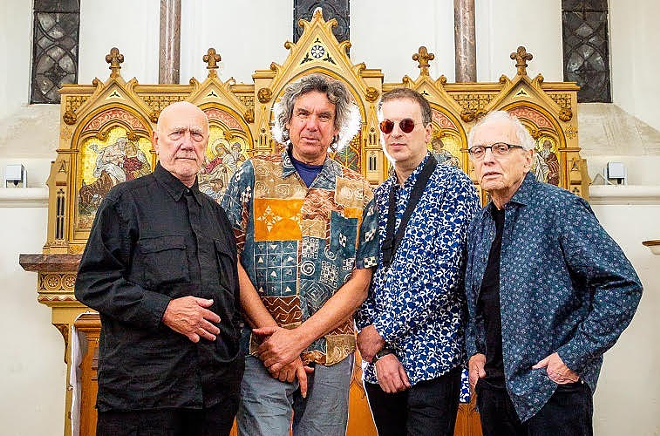When saxophonist-keyboardist-flutist Theo Travis joined the British psychedelic rock band Soft Machine Legacy in 2006, he was simply subbing for Elton Dean, who had been with the band since the late ’60s. Travis was to play just one show, but when Dean passed away, he began playing with the band on a regular basis and has become a full-time member of the veteran group.
“I had worked with all of the guys quite a lot over the previous ten years or so,” says Travis via phone. On its first U.S. tour in decades, Soft Machine plays with Beledo at the Beachland Ballroom at 8 p.m. on Thursday, Oct. 18. “They knew me, and I had worked with them in a jazz context and with more experimental music. They thought I would be suitable at the time. It was initially to cover a gig in two-days time. I managed to move some things around, and it went well. Sadly, the following week, Elton passed away, and I did some more gigs they had wanted to do. They asked me to carry on with the band, and we would see how it would go. That was over 10 years ago, and I guess I’m now in the band.”
Though the lineup has shifted plenty since the band’s formation, the current lineup, which features guitarist John Etheridge, bassist Roy Babbington and drummer John Marshall in addition to Travis, stays so true to the original group’s jazz/progressive rock sound that it’s taken to calling itself Soft Machine and dropped the "Legacy" part of the moniker.
In fact, the current tour represents the group’s first shows in North America since 1974.
“It’s quite exciting, really,” says Travis when asked about the current trek which came to Canada earlier this year. “There’s suddenly lots of interest in the band.”
The tour supports Hidden Details, a terrific new album that the group recorded last year with the late Jon Hiseman, who produced the disc at his Temple Studio in Surrey, England. The album commences with the title track, a tune that features heavy guitars and a woozy saxophone solo. The tunes that follow range from the jazzy "The Man Who Waved at Trains" to the spooky flute-driven closer "Breathe," a song that sounds like it could be a more atmospheric track (albeit without vocals) from prog rockers Jethro Tull.
“Our manager was very motivating,” Travis says when asked how the album came together. “He was keen to get it going. When he did, we started writing new music and gathering ideas. We wanted to play to everyone’s strengths. When the recording dates were set, we started writing some stuff and we rehearsed, and the songs took shape. We had recorded the Steam album with [Hiseman] 2016. The thing about him is that he was right as rain and totally on it. He seemed totally well. It’s his studio, so he knows it inside out. It was a very relaxed environmental.”
The group booked three days and hammered out the tunes. It wound up with enough for a double album and even recorded some extra improvisations, a few of which it put on the fourth side of the album’s double vinyl version.
“There were some parameters. We decided to do various improvisations, some with two of us and some with three of us and some with four of us. One thing with Soft Machine is that there’s a lot of reaching out with the sounds. We used quite a few effects pedals that you can use live. It’s not a post-recording thing. Jon [Hiseman] has a Fender Rhodes in the studio. I wanted to use that, which I do. We use foot pedals to broaden the sounds on the guitars but not on the pianos. That slightly links it to the Mike Ratledge and Karl Jenkins earlier Soft Machine sound. There’s also live looping using effects pedals. We had an imposed discipline of limiting what we do. We wanted it to be experimental but at the same time melodic and have strong compositions and have a kind of warm sound to it, which Jon [Hiseman] was instrumental in. In the last track, ‘Breathe,’ there are particular percussion textures that Jon had that we liked. I like the alto flute on that track as well. It has a particular deep, almost mysterious sound to it."
“Night Sky,” the album’s bonus track, stemmed from one of the session’s improvisational jams.
“We did various ones, some more muscular and menacing and loud and aggressive and some more pastoral and calm,” says Travis. “It’s light and has these layers and is cinematic in a way. It’s just John [Etheridge] and me creating these textures. That was one of our top choices of tracks that didn’t make it to the main album.”
Travis admits using the Soft Machine legacy moniker might have created a bit of confusion with fans. But he feels like the current ensemble represents the original band so well that it makes sense to call it Soft Machine.
“People have an affinity with the Soft Machine name,” he says. “People don’t have an affinity with Soft Machine Legacy. I think it felt like it more and more like it had the spirt of the original in a way. It feels like Soft Machine proper. It’s the same guys as it has been for the past eight years. When you call it Soft Machine, the stakes are higher and we raised the bar a bit because of that. It makes it a bit more real. I think it’s the right thing to do and it makes sense. This is the first recording under the name, and that makes sense, and people listen to it in a different way, and there’s a different level of interest because of that.”


